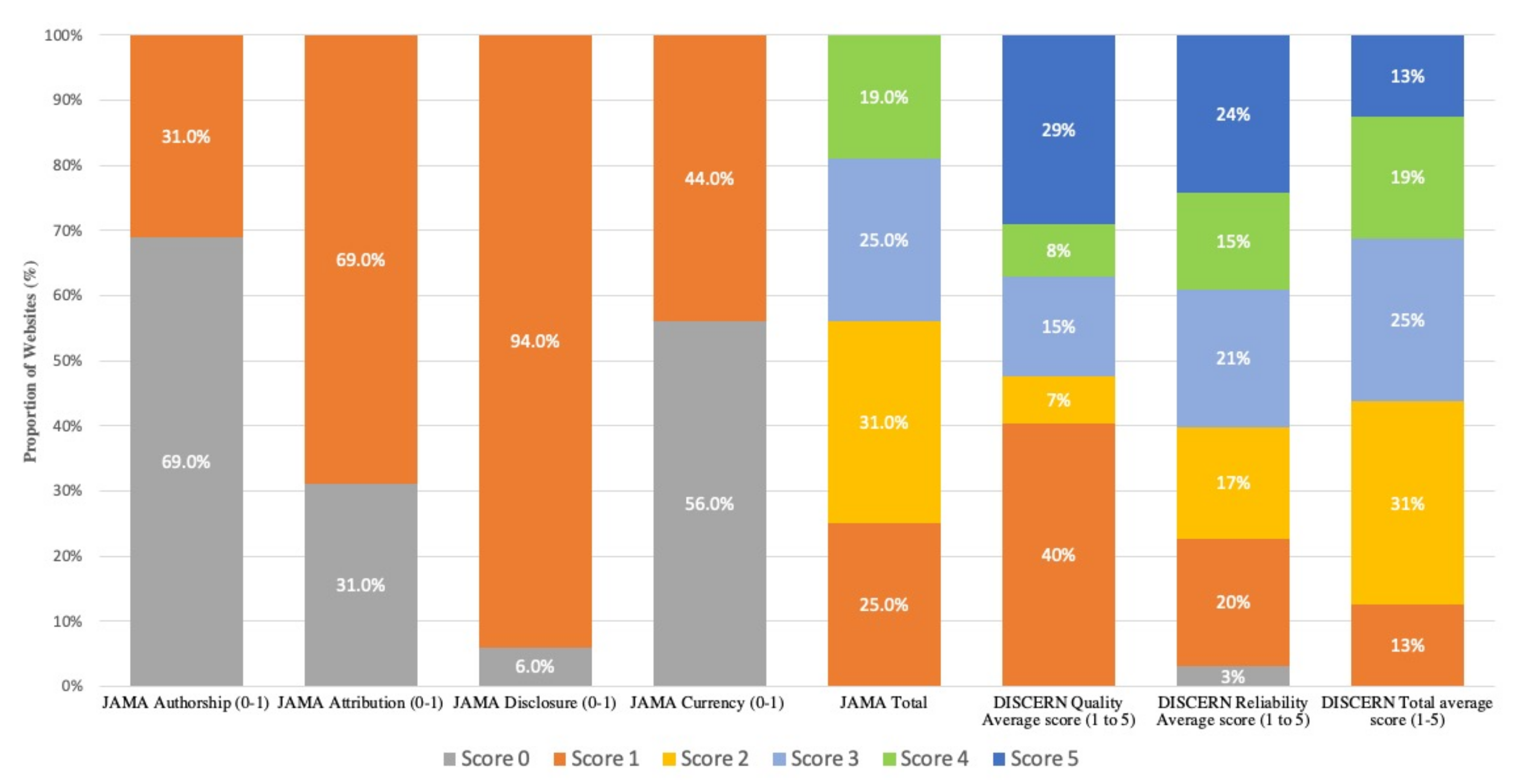The Quality of Online Information for an Uncommon Malignancy—Neuroendocrine Tumours (NETs)
Abstract
1. Introduction
2. Methods
3. Results
4. Discussion
5. Conclusions
Authors Contributions
Funding
Acknowledgments
Conflicts of Interest
References
- Kunst, H.; Groot, D.; Latthe, P.M.; Latthe, M.; Khan, K.S. Accuracy of Information on Apparently Credible Websites: Survey of Five Common Health Topics. BMJ 2002, 324, 581–582. [Google Scholar] [CrossRef] [PubMed]
- Eysenbach, G.; Kohler, C. What Is the Prevalence of Health-Related Searches on the World Wide Web? Qualitative and Quantitative Analysis of Search Engine Queries on the Internet. AMIA Annu. Symp. Proc. 2003, 225–229. [Google Scholar]
- Hallet, J.; Cukier, M.; Saskin, R.; Liu, N. Exploring the Rising Incidence of Neuroendocrine Tumors: A Population-Based Analysis of Epidemiology, Metastatic Presentation, and Outcomes. Cancer 2015, 121, 589–597. [Google Scholar] [CrossRef] [PubMed]
- Silberg, W.M.; Lundberg, G.D.; Musacchio, R.A. Assessing, Controlling, and Assuring the Quality of Medical Information on the Internet: Caveant Lector et Viewor—Let the Reader and Viewer Beware. JAMA 1997, 277, 1244–1245. [Google Scholar] [CrossRef] [PubMed]
- DISCERN—The DISCERN Instrument. Available online: http://www.discern.org.uk/discern_instrument.php (accessed on 26 January 2021).
- Health On the Net (HON): Health on the Net Code of Conduct (HONcode). Available online: https://www.hon.ch/HONcode/ (accessed on 26 January 2021).
- Burke, E.; Harkins, P.; Saeed, M.; Salama, M.; Ahmed, I. “Dr. Google” Will See You Now-Assessing the Quality of Information on Oesophageal Cancer on the Internet. J. Gastrointest. Surg. 2020, 24, 2466–2470. [Google Scholar] [CrossRef] [PubMed]
- Charnock, D.; Shepperd, S.; Needham, G.; Gann, R. DISCERN: An Instrument for Judging the Quality of Written Consumer Health Information on Treatment Choices. J. Epidemiol. Community Health 1999, 53, 105–111. [Google Scholar] [CrossRef] [PubMed]
- Nassiri, M.; Bruce-Brand, R.A.; O’Neill, F.; Chenouri, S.; Curtin, P. Perthes Disease: The Quality and Reliability of Information on the Internet. J. Pediatr. Orthop. 2015, 35, 530–535. [Google Scholar] [CrossRef] [PubMed]
- Feinberg, Y.; Law, C.; Singh, S.; Wright, F.C. Patient Experiences of Having a Neuroendocrine Tumour: A Qualitative Study. Eur. J. Oncol. Nurs. 2013, 17, 541–545. [Google Scholar] [CrossRef] [PubMed]

| BING |
| https://en.wikipedia.org/wiki/Neuroendocrine_tumor |
| YAHOO |
| No website returned that was not a duplicate from Google or Bing. |
Publisher’s Note: MDPI stays neutral with regard to jurisdictional claims in published maps and institutional affiliations. |
© 2021 by the authors. Licensee MDPI, Basel, Switzerland. This article is an open access article distributed under the terms and conditions of the Creative Commons Attribution (CC BY) license (http://creativecommons.org/licenses/by/4.0/).
Share and Cite
Sohail, S.; Zuk, V.; Halfdanarson, T.; Chan, D.; Pattison, S.; Vasdev, R.; Law, C.; Hallet, J. The Quality of Online Information for an Uncommon Malignancy—Neuroendocrine Tumours (NETs). Curr. Oncol. 2021, 28, 842-846. https://doi.org/10.3390/curroncol28010082
Sohail S, Zuk V, Halfdanarson T, Chan D, Pattison S, Vasdev R, Law C, Hallet J. The Quality of Online Information for an Uncommon Malignancy—Neuroendocrine Tumours (NETs). Current Oncology. 2021; 28(1):842-846. https://doi.org/10.3390/curroncol28010082
Chicago/Turabian StyleSohail, Safa, Victoria Zuk, Thorvardur Halfdanarson, Dadvid Chan, Sharon Pattison, Ravleen Vasdev, Calvin Law, and Julie Hallet. 2021. "The Quality of Online Information for an Uncommon Malignancy—Neuroendocrine Tumours (NETs)" Current Oncology 28, no. 1: 842-846. https://doi.org/10.3390/curroncol28010082
APA StyleSohail, S., Zuk, V., Halfdanarson, T., Chan, D., Pattison, S., Vasdev, R., Law, C., & Hallet, J. (2021). The Quality of Online Information for an Uncommon Malignancy—Neuroendocrine Tumours (NETs). Current Oncology, 28(1), 842-846. https://doi.org/10.3390/curroncol28010082





